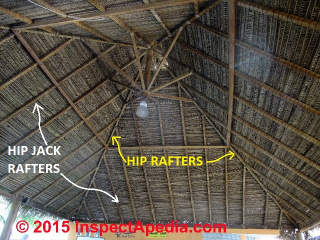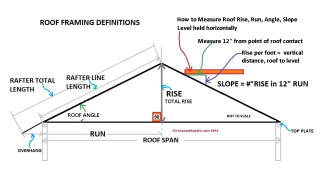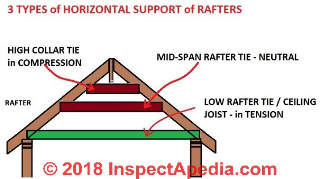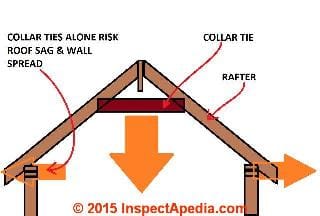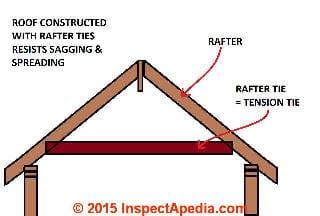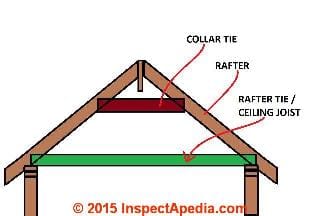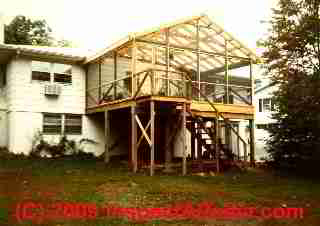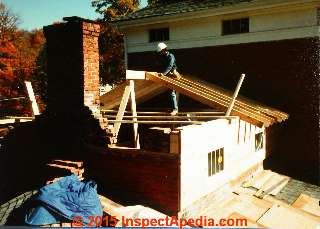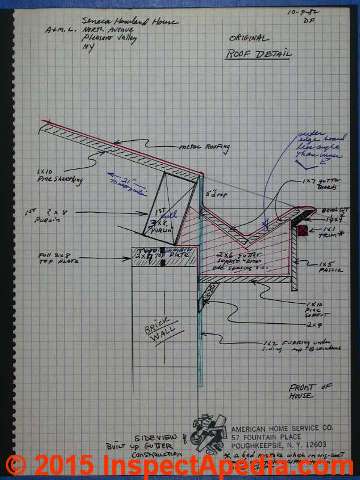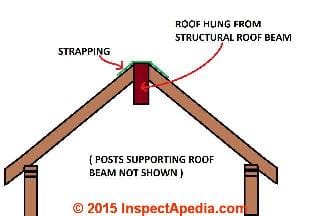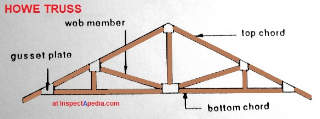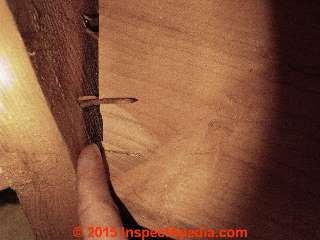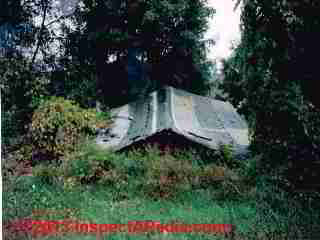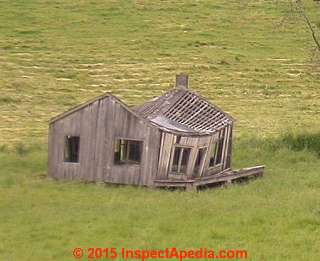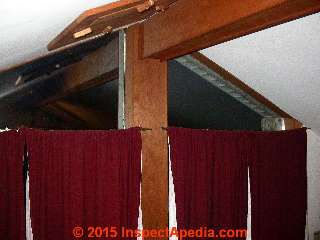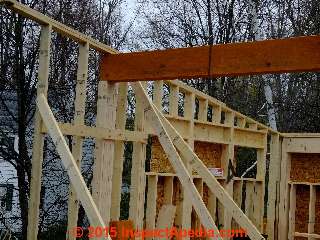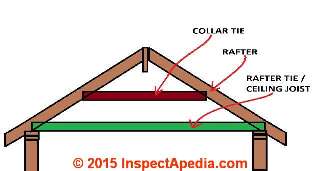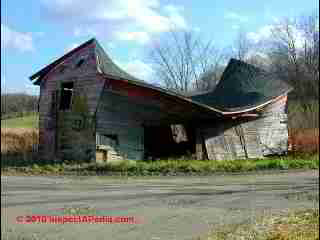 Roof Framing Definitions
Roof Framing Definitions
Common rafter, Valley rafter, Valley jack rafter,
Hip rafter, Hip jack rafter,
Cripple Jack rafter, Dormer rafter
Collar Ties, Rafter Ties, Structural Ridge Beams
- POST a QUESTION or COMMENT about roof framing, support, construction specifications & practices
Roof Framing: collar ties, rafter ties, tension beams & structural ridge beams: some of these can support the roof and prevent ridge sagging and wall spreading.
Roof structure definitions & support choices for sloped roofs, cantilevered roofs & cathedral ceiling roofs.
This article series describes and illustrates the different types of support that prevents roof sagging and wall bulging at buildings, including definitions of collar ties, rafter ties, and structural ridge beams.
Without the proper support of rafter ties or a structural ridge, a typical gable or sloped roof will sag downwards while pushing the building walls outwards towards a catastrophe such as that shown in our page top photo of a barn in Amenia, NY: the failure of rafter ties in this building combined with snow loading in Amenia, New York, pushed the ridge down and the walls outwards as the building slowly settles down to the earth.
Here we include sketches of collar ties, rafter ties, and structural ridge beams as well as illustrations of collapsing and collapsed structures where these roof rafter ties were lost or omitted.
InspectAPedia tolerates no conflicts of interest. We have no relationship with advertisers, products, or services discussed at this website.
Roof Framing Definitions
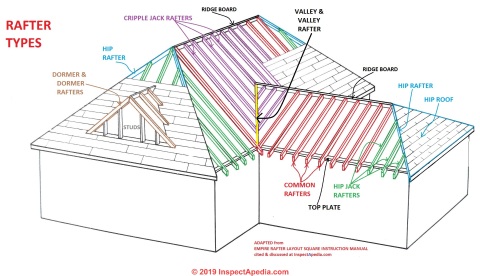 Below we give the locations and functions of various roof framing members, rafter types, collar ties, rafter ties, ceiling joists, and structural ridge beams.
Below we give the locations and functions of various roof framing members, rafter types, collar ties, rafter ties, ceiling joists, and structural ridge beams.
What are the Names of the Different Types of Rafters?
And where are they found in which roof shapes or sections?
[Click to enlarge any image]
Drawing adapted from Swanson's Book of Rafter Lengths and Roof Construction that was in turn copied in Empire Level Co.'s Rafter Square Instruction Manual both of which are cited below.
Common Rafter
Definition of Common Rafter
shown in red in our sketch, a common rafter runs at right angles to (90°) to the building front and back walls, as seen when looking down from above. A common rafter runs from the roof ridge to the top of the front or rear wall plate, and extend beyond the wall to provide an overhang or eaves or soffit.
In our rafter type drawing above common rafters are drawn in red.
Cripple Jack Rafter
Definition of Cripple Jack Rafter or Valley Jack Rafter
a rafter running at right angles (90°) from the ridge of a roof down to the valley below. Cripple jack rafters or valley jack rafters never make it to a wall top plate - instead they intersect a valley formed by another roof.
In our rafter type drawing above the cripple jack rafters are drawn in purple and the valley location or valley rafter is drawn in yellow
The valley itself is formed where the hip roof abuts a lower or adjoining roof surface.
Dormer Rafter
Definition of Dormer Rafter
a rafter whose upper end rests atop an existing roof without cutting into it, providing a roof and ceiling for a dormer or building space with greater head-room than beneath the main roof.
A roof dormer may be gabled as in our sketch above or it may be a low-slope, or flat roof.
Hip Rafter
Definition of Hip Rafter
a rafter that runs diagonally between the roof ridge and the top of the wall plate, forming a hipped roof.
In our rafter type sketch above the hip rafters are drawn in blue. Notice that the hip rafter forms what amounts to a descending ridge - a single line that starts at the top of the roof and descends to the wall top plate at a wall corner.
Below: a hip rafter and jack rafters viewed from below. This is a woven palm thatch roof located in La Manzanilla, Mexico.
The hip rafters extend from the ridge down to the top plate and are marked in our photo by yellow arrows. This is a pyramid roof so there is no ridge board. All of the hip rafters meat at the ridge peak.
Hip Jack Rafter
Definition of Hip Jack Rafter
a rafter extending at right angles (90°) from the top of the wall plate and up to abut into an existing hip rafter.
Above the hip-jack rafters are indicated by the white arrows - in the photo.
In our roof framing drawing above the hip jack-rafters are drawn in green.
Valley Rafter
Definition of Valley Rafter or cripple jack rafter
a rafter extending from the roof ridge down to the top plate of a wall at the intersection of a gable extension roof that itself abuts or intersects with the main roof.
In the sketch above the valley rafter is drawn in yellow.
Definitions of Rafter Span & Run, Roof Span & Slope, Collar Ties
[Click to enlarge any image]
Definition of rafter span
the un-supported length of the rafter along its slope - the diagonal or hypotenuse of a right triangle. In our sketch the "rafter span" is referred to as the RAFTER LINE LENGTH.
Definition of rafter run
the horizontal or level distance covered by the rafter - the bottom chord or base of a right triangle. In our sketch above the rafter run is shown as RUN under the left half of the roof.
Definition of roof span
normally a roof span is the same as the building width between the outer edges of the wall top plates.
Definition of roof slope
roof slope is the amount of change in height as a ration of horizontal distance traveled, usually expressed as inches of rise per foot of horizontal run, or cm of rise per m of horizontal run.
See details at ROOF SLOPE DEFINITIONS
Depending on its location along the roof rafter span or run, a horizontal tie or reinforcement may enjoy different names and suffers different forces. We detail these below:
- Definition of Collar ties
High horizontal ties in the upper third of the roof - under compression - Definition of Mid-Span rafter ties
located horizontally in the middle of the rafter's run or horizontal span - neutral & varying - Definition of Low rafter ties
located in the bottom third or at the bottom of the rafter's run or horizontal span - under tension
Definition of Collar Tie in Roof Framing
A collar tie is a horizontal roof rafter compression connector that is located in the uppermost third of the span of a pair of opposed sloped or "gable roof" rafters.
By upper third, here we mean one third of the length of the rafter from ridge to top plate. In finding this location we do not count the additional length of the rafter that supports the roof eaves, overhang, or soffit.
A collar tie is used to prevent rafters from separating from the ridge, a structural failure that can be caused by snow loads, wind loads, or un-balanced roof loading for any other event or force that causes the roof to begin to move downwards or to collapse.
[Click to enlarge any image]
Above: a roof framed with just collar ties, or with nothing but a ridge board, is unable to resist sagging at the ridge and outwards bulging at the side walls unless specially-engineered features are included. So what good is a collar tie anyway?
Collar ties help keep the rafters against the ridge board when there are un-balanced roof loads such as during high winds or when most of the snow load is on one slope but not the opposing slope of a roof. (Mathscinotes 2010 & Truesdell 2008).
Watch out: located in the upper third of a gable roof, and particularly for larger roofs with a longer run or span, a collar tie are not likely to prevent rafter sagging from uniform vertical loading and thus may not prevent spreading or bulging walls when the roof is loaded by downwards forces including its own weight.
Why do some roofs get away with just high collar ties? Take a look at the roof pitch. On a very steep-pitched roof, the horizontal loading caused by roof spreading forces is less than on a low slope roof.
See ROOF SLOPE TABLE, TYPES, WALKABILITY
Really? There is some confusion among writers about whether the upper roof collar tie is under compression or under tension.
As you will read below at COMPRESSION vs TENSION in ROOF FRAMING and as Mark Cramer, home inspection expert says, " ... it depends".
Until the roof begins to collapse the upper areas are pressing in against the ridge board and are under compression. But when a roof ridge begins to move downwards or to collapse, that situation changes from compression to tension.
See SAGGING ROOF REPAIR for a description of a project to straighten a badly-sagged roof.
Definition of Rafter Tie used in Roof Framing
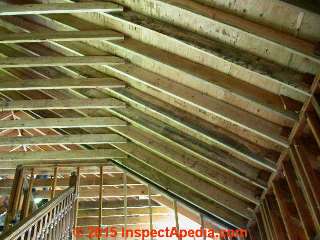 What are those horizontal 2x members in the roof frame photo just above?
What are those horizontal 2x members in the roof frame photo just above?
Speaking carefully, if these horizontal members are at mid-span or in the middle of the rafter's length from ridge to top plate.
These are mid-span rafter ties and are not collar ties (located in the rafter's top 1/3 of its length) nor rafter ties (found in the rafter's bottom 1/3) of the rafter's length.
Does it matter what you call these horizontal roof framing members?
Sometimes yes, as we'll explain here.
[Click to enlarge any image]
Definition
A rafter tie is a horizontal tension tie that is located in the lowermost third of the span of a pair of opposed sloped or "gable roof" rafters.
A rafter tie resists spreading of the building walls by bulges at the wall top that would otherwise occur due to roof loads.
Rafter ties greatly increase the resistance of wood structures to wind damage when compared to simple toe-nailing rafters to plates. Liu (1993)
A ceiling joist that is affixed to the ends of rafters (and normally also to the top plate of the wall) is also a rafter tie: located at the wall top it forms the bottom of the roof triangle as you can see in our sketch below.
Depending on the building design, finished ceiling surfaces may be affixed to a ceiling joist at the bottom of the roof triangle, giving a flat ceiling between the opposing building walls, or the ceiling may be affixed partly to the under-side of rafters and partly to the under-side of rafter ties, giving a Cape Cod type ceiling design.
Definition of Mid-Span Rafter Ties
Definition: a mid-span rafter tie is a horizontal reinforcement member connected to a pair of opposing rafters and located in the middle of the rafter's span or run.
In our sketch above, the mid-span rafter tie is shown as under "neutral" force.
That's really only true in comparison to the forces on the higher collar tie in the upper 1/3 of the roof or the lower rafter tie in the lower 1/3 of the roof.
In practice, temporary loads placed on the center of the roof such as from snow, workers, or bundles of shingles during re-roofing will press inwards and the mid-span rafter tie will be under compression.
An example of retrofitting mid-span rafter ties is at SAGGING ROOF REPAIR where sagged rafters are jacked straight and mid-span horizontal 2x lumber is nailed in place, replacing older collar ties that were located near the ridge.
Rafter tie or Collar Tie Spacing Intervals & Connection Specifications
Building codes such as the ICC's 2012 International Building Code section 2308.10, Roof and Ceiling Framing typically specify that where rafter ties are used, they are required at intervals ranging from 12" to 24" o.c. depending on the roof design and the roof rafter spacing. Where rafter ties are not being installed with every rafter pair, model codes often specify that
Rafter ties shall be spaced not more than 4 feet (1219 mm) on centers and rafter tie connections shall be based on the equivalent rafter spacing in [a table given in the code, such as ICC Table 2308.10.4.1]
The following is excerpted from the International Code Council (ICC)'s International Building Code section on Ceiling Joist and Rafter Connections
2308.10.4.1 Ceiling joist and rafter connections.
Ceiling joists and rafters shall be nailed to each other and the assembly shall be nailed to the top wall plate in accordance with Tables 2304.9.1 and 2308.10.1.
Ceiling joists shall be continuous or securely joined where they meet over interior partitions and fastened to adjacent rafters in accordance with Tables 2308.10.4.1 and 2304.9.1 to provide a continuous rafter tie across the building where such joists are parallel to the rafters. Ceiling joists shall have a bearing surface of not less than 11/2 inches (38 mm) on the top plate at each end.
Rafter ties shall be spaced not more than 4 feet (1219 mm) o.c. Rafter tie connections shall be based on the equivalent rafter spacing in Table 2308.10.4.1.
Where rafter ties are spaced at 32 inches (813 mm) o.c., the number of 16d common nails shall be two times the number specified for rafters spaced 16 inches (406 mm) o.c., with a minimum of four 16d common nails where no snow loads are indicated.
Where rafter ties are spaced at 48 inches (1219 mm) o.c., the number of 16d common nails shall be two times the number specified for rafters spaced 24 inches (610 mm) o.c., with a minimum of six 16d common nails where no snow loads are indicated.
Rafter/ceiling joist connections and rafter/tie connections shall be of sufficient size and number to prevent splitting from nailing. - ICC 2012, http://publicecodes.cyberregs.com/icod/ibc/2012/icod_ibc_2012_23_par196.htm
Table 2308.10.4.1, Rafter Tie Connections, relates rafter slope, rafter tie spacing, and roof load ratings or snow load ratings and also roof span in feet.
The local building code inspector is the final authority, and your local building codes and inspectors may have different requirements.
Above: one of the author's [DF] construction projects in the 1970's, the Weeks' corrugated-fiberglass-panel covered porch in Poughkeepsie, NY, was framed placing rafter ties at mid-span.
Below, the author framing a raised-roof on the Seneca Howland historic home in Pleasant Valley, New York in 1982.
Below: adding ceiling joists below this rather low-sloped roof required adding a short wood-framed wall that itself had to be anchored to the original brick wall of this building extension.
Forming a very rigid roof triangle was particularly important to eliminate any risk that roof loads might push the added-on cripple walls outwards. I'm using a 2x ridge board that did not form a structural ridge.
You can see temporary 2x lumber placed horizontally to tie the front and rear walls together before we added ceiling joists (yet yet installed) that were to be nailed to the top plates and to the rafters.
The roof structure above can be seen near completion at SENECA HOWLAND HOUSE - links to various photos of this home as they appear at InspectApedia.com.
Below is a sketch of the original roof-wall structural details for this building.
The original roof was built using purlins, beams extending between gable-ends. The roof sheathing consisted of inch-thick wide pine boards nailed to the purlins and thick enough to resist (much) sagging.
That "tipped" purlin at the top of the brick wall is no mistake, that's how it was framed - tipped as shown.
Rafter Support when Rafters are at Right Angles to the Ceiling Joists
Where ceiling joists are installed, if the ceiling framing is not in parallel with the rafters, then equivalent rafter ties are required to be added, or a knee wall (dwarf wall) can be used when placed on a supporting beam that sits on the building the tops of the wall plates of the exterior walls.
The top of the raised beam should be at least 1" above the finished ceiling that runs below the ceiling joists in order to prevent any telegraphing of roof loads through the finished ceiling below.- CMHC 2014
Where ceiling joists are not parallel to rafters, an equivalent rafter tie shall be installed in a manner to provide a continuous tie across the building, at a spacing of not more than 4 feet (1219 mm) o.c.
The connections shall be in accordance with Tables 2308.10.4.1 and 2304.9.1, or connections of equivalent capacities shall be provided.
Where ceiling joists or rafter ties are not provided at the top of the rafter support walls, the ridge formed by these rafters shall also be supported by a girder conforming to Section 2308.4.
See details at COMPRESSION BRACING for RAFTERS (Canada)
Definition of Structural Ridge or Ridge Beam used in Roof Framing
A structural ridge beam is a horizontal beam placed at the peak or ridge of a roof and is designed to carry much of the live and dead loads or weight of the roof structure by itself.
The loads on the ridge beam are carried by vertical posts at the beam ends down through the building structural walls to the building foundation. A ridge beam essentially allows us to hang a roof over the beam such that rafter ties can be omitted, giving a cathedral ceiling with a completely open space below.
In Howe & Fink Trusses the bottom chord is also a tension tie
These illustrations illustrate two common wood roof truss designs: the Fink Truss and the Howe Truss. The bottom chord of these roof trusses is serving as a tension tie: it is in tension and is holding the top chords of the truss against spreading
. It is because the bottom chord of a roof truss is in tension that the truss member can be as small as a 2x4.
However the weight of a ceiling affixed to rafter ties of any dimension can cause ceiling sagging unless the lumber is also sized to support the vertical load or weight of the ceiling.
In a roof truss design, the additional web members of the truss help resist sagging of the bottom cord and add rigidity to the truss structure.
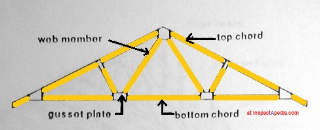
See Framing Methods Age for the history and date ranges of various building framing methods.
Which roof framing members are in tension & which in compression?
In our sketch shown hthe mid-span rafter tie is shown as under "neutral" force. That's really only true in comparison to the forces on the higher collar tie in the upper 1/3 of the roof or the lower rafter tie in the lower 1/3 of the roof.
In practice, temporary loads placed on the center of the roof such as from snow, workers, or bundles of shingles during re-roofing will press inwards and the mid-span rafter tie will be under compression.
Mathematicians and engineers discussing collar ties and rafter ties explain that collar ties and rafter ties (or ceiling joists) under a gable roof are in enormous tension and that the mathematics of the roof forces are the same for collar ties and rafter ties.
That's true for horizontal ties in the lower third of the roof.
A Tension tie is a general term to refer to any structural member that is subject to net tension: that is, the forces or loads on the member place it in tension or "stretching" forces. The most-common tension tie observed in roof framing for a conventionally-framed gable roof is the ceiling joist that forms the bottom chord of the roof triangle shown below.
By fastening the lower rafter ends to the horizontal ceiling joist and the upper rafter ends to the ridge board (or to one another in older framing), the triangular structure is very rigid and resists both rafter sagging and spreading of the building walls that would occur if the ceiling joist were omitted.
Really?: I [DF] and other sources consider that under normal conditions forces on a sloped roof's exterior surface are pressing downwards: a condition that will indeed cause the "triangle" formed by the sloped roof to flatten, pushing out the building walls upon which the lower edges of the roof are resting and to which they're normally fastened.
But near the ridge, these forces tend to press the rafters inwards against the ridge board (or against the opposing rafter in each rafter pair.
So the top of the roof is in compression, and collar ties near the upper roof should also be in compression, not in tension.
An exception occurs however, even near the ridge, if the bottom of the roof triangle is not secured against stretching or flattening by a ceiling joist or a low-placed rafter tie.
When these framing members have been omitted, and when there is no structural ridge design over which a roof is suspended, the inwards-force on the upper roof combined with the downwards movement of the ridge will pull the lower half or more of the rafter away from the ridge board. You can see this in my photo just below.
To me this phenomena argues that a mathematician's observation that "all the roof loads are specified as if they were in the horizontal plane" could be proper, but it may ignore horizontal forces that occur within the roof structure such as those that lever or pull away a rafter from the ridge when a roof ridge moves downwards for any reason.
The engineers and mathematicians define the first view as a "static" or "non-rotating" situation. (Mathscinotes 2010 & Truesdell 2008).
My concern, that seems secondary, is for a situation that includes rotating forces. But in fact it might be that rotating forces (photo above) may be the proximate cause of connection failures and more calamitous collapse in some cases.
Forces & Direction of Movement in Sagging & Collapsing Roofs
Please see these three separate articles now found at
Stages in the Collapse of a Roof Without Rafter Ties
We moved this discussion to its own article space now found
Structural Ridge vs. Ceiling Joists vs. "Nothing" for Cathedral Ceilings
We have moved this discussion to CATHEDRAL CEILING / ROOF SUPPORT REQUIREMENTS - Paul DeBaggis
“Where ceiling joists or rafter ties are not provided, the ridge formed by these rafters shall be supported by a wall or girder designed in accordance with accepted engineering practice.” - 2012 IRC, Section R 802.3.1
Using a Structural Beam with a CantiLevered Roof
We moved this discussion. Please see CANTILEVERED ROOF SUPPORT REQUIREMENTS
Below we're installing a structural beam supported by posts carrying the roof loads to the foundation and footings of this building addition by one of the authors, working with builder Eric Galow in Poughkeepsie, New York.
Intermediate Roof Collar Ties as Compression Supports: Canadian Roof Framing Specifications
This discussion is now found at COMPRESSION BRACING for RAFTERS (Canada)
Proper placement & connections of collar ties and ceiling joists are required for gable and hip roofs in order to avoid sagging rafters and worse, collapsing roofs. Here we describe Canadian roof framing guidelines.
Useful Roof Framing References
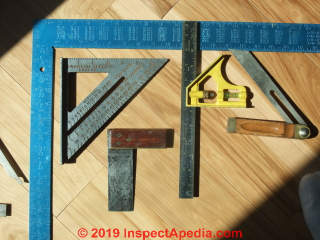
- Empire Level Corporation, Empire Rafter Layout Square Instruction Manual, Empire Level Manufacturing Corp., 10930 West Potter Rd., Milwaukee WI 53226 USA, TEl: 414-774-3388. Empire provides framing squares illustrated
at our FRAMING SQUARE USER'S GUIDE
and a neat roof pitch and angle tool that we illustrate
at ANGLE FINDER LEVEL, also combination squares, levels, other tools. - Radford, William A., 1865-; Woods, Alfred W., joint ed; Reuther, William, Eds, Vol 1: THE STEEL SQUARE and ITS USES a complete, up-to-date encyclopedia on the practical uses of the steel square [PDF] Industrial Publication Co., New York 1907
- Swanson, THE SPEED SQUARE Swanson's Book of Rafter Lengths and Roof Construction [PDF] (1982) Swanson Tool Co., Inc., PO Box 434, Oak Lawn IL 60543, Tel: 312-599-9029.
Note that while today there is an avalanche of speed squares or rafter squares on the market, made by many tool manufacturers, Swanson's appears to be the original device. I've still got mine from about 1976. - U.S. Navy, ROOF FRAMING [PDF] NAVEDTRA, Chapter 10, Naval Education & Training, includes detailed examples of using the framing square and framing square tables
Reader Comments, Questions & Answers About The Article Above
Below you will find questions and answers previously posted on this page at its page bottom reader comment box.
Reader Q&A - also see RECOMMENDED ARTICLES & FAQs
On 2021-03-17 by (mod) - collar ties and forces on roof?
I am guessing you're asking about the horizontal framing member under the upper roof slope and - confusing - extending out to the face of a dormer - or maybe not, depending on where under the roof we're framing.
I'm also guessing that the concern is that uneven loading in the roof framing might try to "pull-in" that front vertical dormer wall - not something that in my OPINION (I'm not a structural engineer) is actually a possibility as long as all of the framing connections around the triangle formed by the roofs and the horizontal tie are secure.
A triangle is a very strong structural element.
Yes, the loads on that upper horizontal tie are not in balance between two very different roof slopes, sizes, areas; happily the bottom chord of a triangle is normally in tension; check with your architect, but I suspect she'll say that as the chord is in tension, the "down" load at the dormer versus at the more-steeply-sloped opposing roof surface all keep the chord in tension so the horizontal stress is distributed fine.
In framing like I THINK we see in your sketch, the down-load of the front half of the less-steeply-sloped domer roof is carried by a vertical wall (and perhaps a header over a window if a window is present) down to the first floor wall and thence to the foundation and footing.
Can you try attaching a larger or sharper high resolution image, Chris? I clicked to enlarge your drawing but still can't make out for sure which framing components we're discussing
On 2021-03-17 by Chris
In the attached picture, the component labeled 'H Collar Tie' attaches to the front rafters in the upper 1/3, but to the shed dormer rafters at the bottom.
So... which are they? It seems that the forces in the tie (whatever sort it is) would be unbalanced back to front. Does the king post have a function other than keeping the 'H Collar Tie' from bowing?
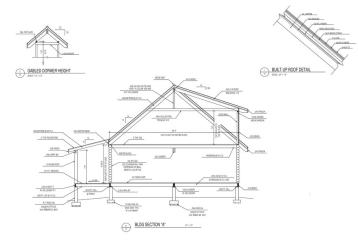
On 2020-11-02 - by (mod) -
OPINION
I doubt it's necessary considering the structure
- is completely open on two sides
- partly open on the other two sides
- is not insulated (no worry about wet roof decking or insulation or moisture trap)
AND
I pose that because the roof, though not steep, slopes enough that condensation on its underside will run down to the eaves and drip off there rather than dripping onto the heads of (and thus annoying ) the hot tub occupants.
On 2020-11-02 by Steven Mahr
A gazebo roof with only four hips and no ridge would be called what 12'3 x 12'3 total wall length squared.
And should it be vented with a hot tub under it

On 2020-03-04 by Anonymous
Vimal
Collar ties as described above on this page are normally in tension (or less often and less properly sometimes in compression) - in both of those uses framers use a 2x4 or 2x6 at most. It's the nailing or fasteners that's important as well as placement of the tie beam at the proper height above the attic floor.
On 2020-03-03 by Vimal Girihagama
How do you design and size a timber ceiling tie beam
On 2019-11-02 by zailani sadauki
Better
On 2019-10-28 - by (mod) -
I'd use 2x10's 16" o.c. - and for usable storage space I'd make the roof much steeper so that you have more headroom
Also it'd make sense to also check with your local building department.
See details at ROOF SLOPE CALCULATIONS https://inspectapedia.com/roof/Roof_Slope_Calculation.php
On 2019-10-24 by Russell goldie
I live in oshawa ont not alot of snow sometimes i am building a garage 16'x21' with a 4/12 pitch single story its 15' from the ground to the peek was hoping to get as much storage as possible in the attic area what type of rafter should i use
On 2019-10-24 by (mod) - raise the roof pitch to get usable storage area
I'd use 2x10's 16" o.c. - and for usable storage space I'd make the roof much steeper so that you have more headroom
Also it'd make sense to also check with your local building department.
See details
and
at COMPRESSION BRACING for RAFTERS (Canada)
On 2019-10-24 by Russell goldie
I live in oshawa ont not alot of snow sometimes i am building a garage 16'x21' with a 4/12 pitch single story its 15' from the ground to the peek was hoping to get as much storage as possible in the attic area what type of rafter should i use
On 2018-11-30 by (mod) - Can you jack up the ridge beam back in place and then just add more nails to collar ties?
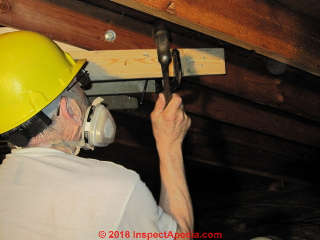 I don't think that's likely to be effective.
I don't think that's likely to be effective.
More likely you'll need to remove the existing collar ties or compression bracing, then re-install it when the roof is jacked into position.
See details at
On 2018-11-30 by Dave - how to fix a sagging roof
Can you jack up the ridge beam back in place and then add more nails to collar ties?
On 2018-11-21 by (mod) -
Ace
Thanks for your remarks. I agree that it is very important for anybody, a homeowner, home inspector, contractor, as well as an architect or engineer to know her limitations and to take care not to bluff and guess - there are life safety concerns, cost concerns, and plain decency.
A problem too often is we don't know that we don't know something.
However that does not mean that we need to call an expensive service for every possible adjustment or repair task around a home. A smart amateur who is willing to read the manufacturer's instructions on replacing some singles may in fact do a better job than a contractor who thinks the purpose of the instructions is to use them to kneel on so he reduces the wear on his jeans.
About scary comments: I agree we need to take care in responding to readers questions; and we do.
I will very much welcome any specific criticism, content suggestions, or corrections if you have that inclination. Ace.
On 2018-11-21 by ace
the discussion above really doesn't look at wind. all things with downward load are the opposite with wind. the glaring example is the collar tie... it acts to prevent a certain failure along the ridge line during a hurricane (or, i suppose, an adequately wussy tornado); sheathing will still need extra nails, but it keeps the ridge together. collar ties also provide increased rigidity in most cases, depending on the connection's drift.
a bunch of stuff in this comment section is scary. the building code is there to keep something complex simple. if you step outside of it, you go back to complex. presume you need an engineer.
On 2018-02-18 by (mod) - big concerns about this our builder was a fraud and my roof is sagging and outside walls r starting to bend out
Jimmies
Watch out: you need an on-site structural or civil engineer who has experience and expertise in residential construction.
An immediate question is whether or not the building is safe
On 2018-02-17 by Kimmi Anderson
Hi I have just put on an extension on our home and I have big concerns about this our builder was a fraud and my roof is sagging and outside walls r starting to bend out and house is lifting at front on one corner and deepening in far back corner wat do I do
On 2017-03-13 by (mod) -
Meghan
As I'm both not qualified and too scared to bet your money and safety on so little information about a building I can but give a genearl suggestion:
Typically we can eliminate ceiling framing if we add a structural ridge beam supported by posts at either end. Sometimes on a wide building we still need a few wall ties at the level of or a bit above the original ceiling height.
But I can't suggest a specific beam design: for that you need an on-site engineer or architect who will examine the existing structure and look at the loads involved.
On 2017-03-13 by Meghan
We have a 23x12 ft room that we are looking at opening up the flat ceiling. The rafters are parallel with the long side the the room and there is one beam (3 2x6s) that seems to be a rafter tie running this long length of the room. Looks to have a 2x6 coming down from the peak of the roof at the ridge board down to the beam.
The ceiling joist 2x4s are running at right angles to the beam and rafters across the 12ft span of the room. These joists are below the beam and are "tied" to it by 2x4.
We were told that the joists are not providing structural support and were merely for affixing the flat ceiling. We had hoped to remove these joists and wonder if the 23 ft beam of 3 sandwiched 2x6s (board seems are staggered) will have any sagging issues if we did. There are collar ties at in the top third but no other rafter ties besides this beam.
On 2016-09-17 by (mod) -
Gena you need to decide first if you're going to have an un-vented design or a vented roof. Having vents in just the soffits as you describe won't do a thing for the roof nor the building as there is incomplete entry vent opening and no exit vent opening.
You also need to decide the amount of insulation wanted - the R-value. In turn that depends on where the retreat cabin is located and how it's used and how it's heated. E.g. in a very cold climate you might want more than the R19 you could get in a 2x6 framed roof with fiberglass batts.
First specifiy the requirements. Then you can choose an insulation scheme. Search InspectApedia for HOT ROOF DESIGN to see some suggestions.
On 2016-09-16 by gena
2x6 rafters, no ridge vent, 2x10 ridge beam, no ridge vent. how to insulate? soffit is vented every other space amost except over door. 10 x 16 retreat cabin. caulked, primed and painted most of sheathing.
...
Continue reading at CATHEDRAL CEILING / ROOF SUPPORT REQUIREMENTS or select a topic from the closely-related articles below, or see the complete ARTICLE INDEX.
Or see these
Recommended Articles
- BUILDING CODE DOWNLOADS - free downloadable PDF files of building codes & standards
- FRAMING DAMAGE, INSPECTION, REPAIR - home
- LVL Laminated Veneer Lumber, Beams
- ROOF FRAMING TIES & BEAMS - home
- CATHEDRAL CEILING / ROOF SUPPORT REQUIREMENTS
- CANTILEVERED ROOF SUPPORT REQUIREMENTS
- COMPRESSION BRACING for RAFTERS (Canada)
- COMPRESSION vs TENSION in ROOF FRAMING
- CUTTING HOLES in WOOD I-JOIST WEBS, JOISTS, RAFTERS, STUDS
- DEFINITION of COLLAR TIE
- DEFINITION of RAFTER TIE
- DEFINITION of MID-SPAN RAFTER TIE
- DEFINITIONS, ROOF FRAMING
- DEFLECTION in WOOD BEAMS ROOFS FLOORS
- FRAMING SQUARE USER'S GUIDE
- HURRICANE TIE DOWN CONNECTORS & FASTENERS
- RAFTER TIE SPACING & CONNECTIONS
- RAFTERS NOT PARALLEL to CEILING JOISTS
- HORIONTAL THRUST in ROOFS
- ROOF BENDING, SAGGING, COLLAPSE
- ROOF SLOPE CALCULATIONS
- ROOF SLOPE DEFINITIONS
- ROOF SLOPE TABLE, TYPES, WALKABILITY
- SAGGING ROOF REPAIR
- STAGES in ROOF COLLAPSE
- STRUCTURAL RIDGE BEAM
- TRUSSES, FLOOR & ROOF
- TRUSS UPLIFT, ROOF
- WOOD STRUCTURE ASSESSMENT
Suggested citation for this web page
ROOF FRAMING TIES & BEAMS at InspectApedia.com - online encyclopedia of building & environmental inspection, testing, diagnosis, repair, & problem prevention advice.
Or see this
INDEX to RELATED ARTICLES: ARTICLE INDEX to BUILDING STRUCTURES
Or use the SEARCH BOX found below to Ask a Question or Search InspectApedia
Ask a Question or Search InspectApedia
Try the search box just below, or if you prefer, post a question or comment in the Comments box below and we will respond promptly.
Search the InspectApedia website
Note: appearance of your Comment below may be delayed: if your comment contains an image, photograph, web link, or text that looks to the software as if it might be a web link, your posting will appear after it has been approved by a moderator. Apologies for the delay.
Only one image can be added per comment but you can post as many comments, and therefore images, as you like.
You will not receive a notification when a response to your question has been posted.
Please bookmark this page to make it easy for you to check back for our response.
Our Comment Box is provided by Countable Web Productions countable.ca
Citations & References
In addition to any citations in the article above, a full list is available on request.
- Paul DeBaggis is a building inspector and certified building code official with special interest in the history of and standards for wood products. (The American Wood Standards Committee). Mr. DeBaggis has served in the Easton MA. Building Department since 2002 , has worked as a building trades instructor, and also writes about land use regulations, building regulations, and standards. He is a past president of Southeastern Mass. Building Officials and is currently writing a book on the Massachusetts building code. Email: paul@jenick.net
- Huber, Gregory D. "Framing Techniques as Clues to Dating in Certain Pre-Revolutionary Dutch Barns: Major and Minor Rafter Systems, Lapped Dovetail Joinery, Verdiepinghs and Other Traits." Material Culture 29, no. 2 (1997): 1-41.
- Liu, Henry. "Calculation of wind speeds required to damage or destroy buildings." The Tornado: Its Structure, Dynamics, Prediction, and Hazards (1993): 535-541.
- Marshall, Timothy P. "Lessons learned from analyzing tornado damage." The tornado: Its structure, dynamics, prediction, and hazards (1993): 495-499.
- Mayo, A. P. "Trussed rafter roofs-Load distribution and lateral stability." Structural Survey 2, no. 1 (1984): 12-15.
- Palma, Pedro, Helena Garcia, João Ferreira, João Appleton, and Helena Cruz. "Behaviour and repair of carpentry connections–Rotational behaviour of the rafter and tie beam connection in timber roof structures." Journal of Cultural Heritage 13, no. 3 (2012): S64-S73.
- "The Mathematics of Rafter and Collar Ties", [Web article], Math Encounters Blog, (November 2010), retrieved 2016/04/15, original source: http://mathscinotes.com/2010/11
/the-mathematics-of-rafter-and-collar-ties/ posted by un-named web author using web name mathscinotes. - Shields, Lance David. "Investigation of Through-Tenon Keys on the Tensile Strength of Mortise and Tenon Joints." (2011), MS Thesis, Civil Engineering, Virginia Polytechnic Institute & State University, original source: https://theses.lib.vt.edu/theses/
available/etd-07112011-100606/unrestricted/Shields_LD_T_2011.pdf - Truesdell, Jordan, P.E., "Rafter Ties and Shallow-Pitch Roofs", Q&A, The Journal of Light Construction, (October 2008) posted as PDF at http://mathscinotes.com/wp-content/uploads/2010/11/JLC.pdf
- Utterback, David. "Common Engineering Problems in Frame Construction." Fine Homebuilding (2000): 110-115.
- "Evaluating OSB for Coastal Roofs," Paul Fisette, Coastal Contractor, Winter 2005, online at coastalcontractor.net/pdf/2005/0501/0501eval.pdf . Fisette cites: "Jose Mitrani, a civil engineer and professor at Florida. International University in Miami, was ... Florida’s official damage assessment team. ... After Hurricane Andrew, Florida code advisers ruled OSB sheathing inferior to plywood
- GluLam Structural Wood Products, U.S. GluLam Inc., 4245 W. 166th St., Oak Forest Il. 60452 - email: bevusg@aol.com, 708-535-6506
- I-Joists: "The Evolution of Engineered Wood I-Joists",
Paul Fisette,
Building Materials and Wood Technology
University of Massachusetts, Amherst, MA 01003, 2000 - see U. Mass online article at umass.edu/bmatwt/publications/articles/i_joist.html - Laminated Beams: Radial reinforcement of curved glue laminated wood beams with composite materials", Kasal, Bo and Heiduschke, Andreas, Forest Products Journal, 1 Jan 2004
- OSB: "Evaluating OSB for Coastal Roofs," Paul Fisette, Coastal Contractor, Winter 2005, online at coastalcontractor.net/pdf/2005/0501/0501eval.pdf . Fisette cites: "Jose Mitrani, a civil engineer and professor at Florida. International University in Miami, was ... Florida’s official damage assessment team. ... After Hurricane Andrew, Florida code advisers ruled OSB sheathing inferior to plywood."
- OSB: Timberco TECO is located at 2902 Terra Court,
Sun Praire, WI 53590 USA, 608-837-2790. TECO provides a reference library of .PDF files that can be downloaded by consumers, homeowners, builders, and architects. The association refers to industry standards for oriented strand board OSB products as:
- "DOC PS 2, Performance Standard for Wood-Based Structural-Use Panels. Certified to CSA 0325, Construction Sheathing, or CSA 0437, OSB and Waferboard, OSB is accepted in the National Building Code of Canada, certified to EN 300, Oriented Strand Boards and recognized for structural use in Europe and certified to meet the JAS standard for structural panels in Japan."
- OSB: "Performance of Wood Shear Walls Sheathed with FRP-Reinforced OSB Panels", J. Struct. Engrg. Volume 132, Issue 1, pp. 153-163, Jan. 2006 provides a study on the development and structural testing of a hybrid sheathing panel designed to improve the lateral resistance of light wood-frame shear walls. "FRP" refers to fiber reinforced polymer material that was sandwiched between more conventional exterior OSB layers.
- Best Practices Guide to Residential Construction, by Steven Bliss. John Wiley & Sons, 2006. ISBN-10: 0471648361, ISBN-13: 978-0471648369, Hardcover: 320 pages, available from Amazon.com and also Wiley.com. See our book review of this publication.
- Decks and Porches, the JLC Guide to, Best Practices for Outdoor Spaces, Steve Bliss (Editor), The Journal of Light Construction, Williston VT, 2010 ISBN 10: 1-928580-42-4, ISBN 13: 978-1-928580-42-3, available from Amazon.com
- The Journal of Light Construction has generously given reprint permission to InspectAPedia.com for certain articles found at this website. All rights and contents to those materials are ©Journal of Light Construction and may not be reproduced in any form.
- Building Failures, Diagnosis & Avoidance, 2d Ed., W.H. Ransom, E.& F. Spon, New York, 1987 ISBN 0-419-14270-3
- Building Pathology, Deterioration, Diagnostics, and Intervention, Samuel Y. Harris, P.E., AIA, Esq., ISBN 0-471-33172-4, John Wiley & Sons, 2001 [General building science-DF] ISBN-10: 0471331724 ISBN-13: 978-0471331728
- Building Pathology: Principles and Practice, David Watt, Wiley-Blackwell; 2 edition (March 7, 2008) ISBN-10: 1405161035 ISBN-13: 978-1405161039
- Design of Wood Structures - ASD, Donald E. Breyer, Kenneth Fridley, Kelly Cobeen, David Pollock, McGraw Hill, 2003, ISBN-10: 0071379320, ISBN-13: 978-0071379328
This book is an update of a long-established text dating from at least 1988 (DJF); Quoting:
This book is gives a good grasp of seismic design for wood structures. Many of the examples especially near the end are good practice for the California PE Special Seismic Exam design questions. It gives a good grasp of how seismic forces move through a building and how to calculate those forces at various locations. THE CLASSIC TEXT ON WOOD DESIGN UPDATED TO INCLUDE THE LATEST CODES AND DATA. Reflects the most recent provisions of the 2003 International Building Code and 2001 National Design Specification for Wood Construction. Continuing the sterling standard set by earlier editions, this indispensable reference clearly explains the best wood design techniques for the safe handling of gravity and lateral loads. Carefully revised and updated to include the new 2003 International Building Code, ASCE 7-02 Minimum Design Loads for Buildings and Other Structures, the 2001 National Design Specification for Wood Construction, and the most recent Allowable Stress Design. - Diagnosing & Repairing House Structure Problems, Edgar O. Seaquist, McGraw Hill, 1980 ISBN 0-07-056013-7 (obsolete, incomplete, missing most diagnosis steps, but very good reading; out of print but used copies are available at Amazon.com, and reprints are available from some inspection tool suppliers). Ed Seaquist was among the first speakers invited to a series of educational conferences organized by D Friedman for ASHI, the American Society of Home Inspectors, where the topic of inspecting the in-service condition of building structures was first addressed.
- Domestic Building Surveys, Andrew R. Williams, Kindle book, Amazon.com
- Defects and Deterioration in Buildings: A Practical Guide to the Science and Technology of Material Failure, Barry Richardson, Spon Press; 2d Ed (2001), ISBN-10: 041925210X, ISBN-13: 978-0419252108. >
- Guide to Domestic Building Surveys, Jack Bower, Butterworth Architecture, London, 1988, ISBN 0-408-50000 X
- Historic Preservation Technology: A Primer, Robert A. Young, Wiley (March 21, 2008) ISBN-10: 0471788368 ISBN-13: 978-0471788362
- In addition to citations & references found in this article, see the research citations given at the end of the related articles found at our suggested
CONTINUE READING or RECOMMENDED ARTICLES.
- Carson, Dunlop & Associates Ltd., 120 Carlton Street Suite 407, Toronto ON M5A 4K2. Tel: (416) 964-9415 1-800-268-7070 Email: info@carsondunlop.com. Alan Carson is a past president of ASHI, the American Society of Home Inspectors.
Thanks to Alan Carson and Bob Dunlop, for permission for InspectAPedia to use text excerpts from The HOME REFERENCE BOOK - the Encyclopedia of Homes and to use illustrations from The ILLUSTRATED HOME .
Carson Dunlop Associates provides extensive home inspection education and report writing material. In gratitude we provide links to tsome Carson Dunlop Associates products and services.


